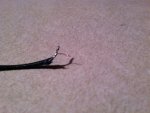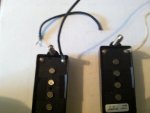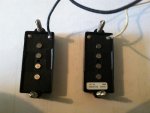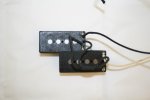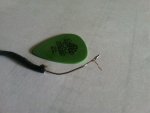famous beagle
Well-known member
Hey everyone, I'm replacing the stock pickup in my SX P-Bass with a Seymour Duncan, and the short wire that connects the two parts came unsoldered (it did this on both pickups, so the wire is totally free now). I know I just need to solder it back to the solder spots, but I started to second guess myself after I stripped a bit of the end off one of the ends.
I noticed that there was one single bronze-colored wire and then some stranded silver color wires.
See the pictures:
Wire 1 is the way it looked after I stripped a bit from the end of the wire.
Wire 2 is the unstripped version (the way both ends looked when they came unsoldered).
So my question is what's up with these wires? Am I supposed to just solder the bronze single wire and not the stranded part? If that's so, it seems counterintuitive, because the bronze wire seems to be entangled with the silver ones anyway.
Or are these both (single bronze and stranded silver) basically the same wire?
Anyone have a clue about this?
Thanks!
I noticed that there was one single bronze-colored wire and then some stranded silver color wires.
See the pictures:
Wire 1 is the way it looked after I stripped a bit from the end of the wire.
Wire 2 is the unstripped version (the way both ends looked when they came unsoldered).
So my question is what's up with these wires? Am I supposed to just solder the bronze single wire and not the stranded part? If that's so, it seems counterintuitive, because the bronze wire seems to be entangled with the silver ones anyway.
Or are these both (single bronze and stranded silver) basically the same wire?
Anyone have a clue about this?
Thanks!

